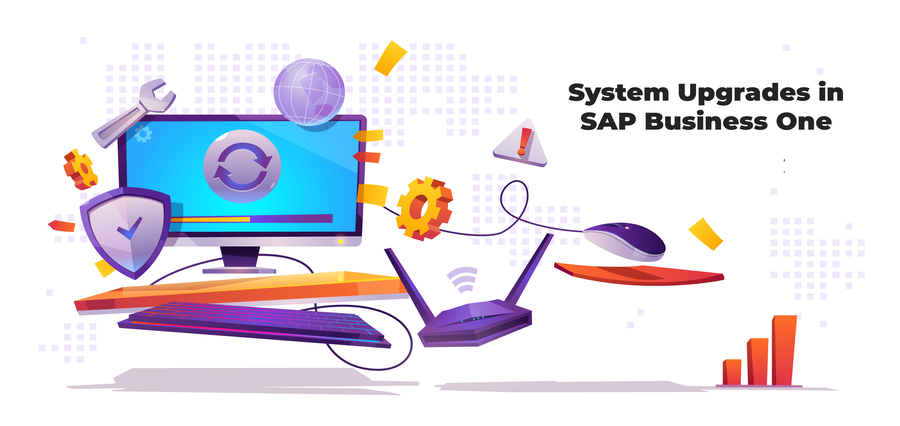As the modern business world grows increasingly competitive and unpredictable, a robust enterprise resource planning (ERP) system like SAP Business One provides a powerful advantage. It seamlessly interweaves various business operations—be it finance, sales, customer relations, or inventory management—into a single, streamlined process. Offering comprehensive visibility and control over key business metrics, SAP Business One is a popular choice among entrepreneurs who aim to drive their businesses forward.
Yet, like all technology, SAP Business One is subject to an evolutionary process. Its developers consistently work on enhancing its features, performance, and security protocols to keep pace with the dynamic business environment. As a result, periodic upgrades are necessary for companies that wish to maintain a robust, effective ERP system and take advantage of its many features and functionalities.
If your business has been using the same version of SAP Business One for quite some time, taking the leap to upgrade may seem daunting. Concerns about potential downtime, data security, and the learning curve associated with new features might be forefront in your mind. Rest assured, however, that a well thought out plan can make the upgrade process so smooth and so swift that you’ll be able to take advantage of the new system’s benefits in no time at all.
Here are four steps you can take to stay on top of the upgrade process for SAP Business One:
Understand New Features and Changes
Before you begin the upgrade proper, sit down and study the enhancements that come with the latest version of SAP Business One, be it new features or performance improvements. You’ll find these changes meticulously detailed in the system’s official release notes and user guides, which can serve as excellent starting points to familiarize yourself with what’s new.
By learning about the system’s changes and new features in detail, you can identify potential benefits and ways to utilize the system for improving your operations. Additionally, you’ll also be able to determine areas where your teams need additional briefing or training, which will in turn give you a head start in preparing staff for the changes to come.
Lastly, knowing about the changes can inform decisions about when to upgrade. For instance, if a particular update introduces features that significantly benefit your operations, it might be prudent to plan the upgrade sooner rather than later. Conversely, if an upgrade has minimal impact on your current use of SAP Business One, you could schedule the upgrade at a less busy time for the business to minimize disruption.
Review the Current System
No two businesses use SAP Business One in exactly the same way. The system’s flexibility allows for various customizations, integrations, and workflows tailored to meet a company’s unique needs. Thus, a thorough review of the current system setup and usage is essential before upgrading. This review will help you foresee and plan for potential changes, making the transition smoother and less disruptive to ongoing operations.
The first aspect to look at is the modules in use. SAP Business One offers a range of configurable modules, covering a large slew of business functions from finance and sales to purchasing and inventory. Understanding which modules your company actively uses can help prepare for changes that the upgrade might bring to these specific modules.
Next, consider any third-party applications that are integrated with the system. These applications often need to be tested with the upgraded system to ensure compatibility and uninterrupted operation post-upgrade.
Finally, review any customizations done to the system. This can include customized reports, workflows, or user interfaces. These customizations need to be carefully evaluated, as they might require adjustments to work seamlessly with the upgraded system.
Back Up All Data
Data has become one of the most precious resources for businesses today, holding the potential to make or break a company’s success. Thus, safeguarding company information is of paramount importance when undertaking an ERP upgrade. Even though SAP Business One’s upgrade process is designed to be safe and secure, it’s always wise to prepare for the unexpected by performing a comprehensive data backup.
This backup should include all types of data used in your SAP Business One system, including transactional data, historical data, and configuration settings. Preserving this data outside of the system puts a helpful safety net in place, reducing the risk of permanent data loss during the upgrade process.
Train Staff
The success of an ERP upgrade isn’t measured merely by the system’s successful installation or the addition of new features. Any software is only as good as the users operating it, which is why your staff must also be able to adapt to the changes and continue their work seamlessly. Providing comprehensive training for all staff members who will be using the upgraded system can equip them with the knowledge and skills they need to make the most of it.
As previously mentioned, the best opportunity to identify your staff’s training needs is early in the upgrade process, when you’re familiarizing yourself with the latest version of SAP Business One. Once you’ve done so, you’ll then need to develop training materials—which can take the form of user guides, instructional videos, or even hands-on workshops. Tailoring the training to the roles of the staff can make it more effective. Identifying these roles for each team—whether it’s for sales or web development—is essential for a smooth transition. For instance, a salesperson would benefit more from a detailed walkthrough of changes in the sales module than a broad overview of the entire system.
You may also find it beneficial to provide additional training sessions once the upgrade is complete. These can give staff members the chance to ask questions and get comfortable with the new system in a supportive environment. The goal is not just to introduce the staff to the system’s new features but to get them confident enough to leverage its capabilities to the fullest.
While upgrading an ERP system is certainly no walk in the park, careful preparation can help your business navigate its challenges and reap its rewards. Your ERP journey doesn’t end with a successful upgrade, either—it’s an ongoing process of learning and adaptation, reflecting the ever-evolving nature of business technology. Stay informed, be proactive, and your business will continue to thrive amidst continual technological advancements.




